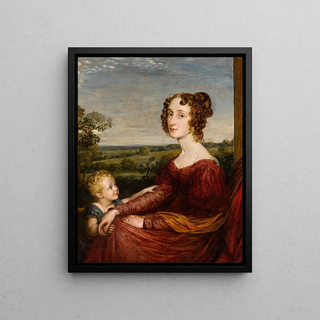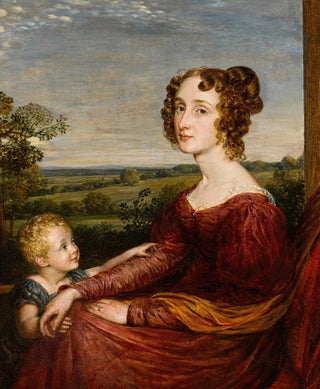Art print | Portrait of Mrs. William Wilberforce and her child - John Linnell


View from behind

Frame (optional)
Portrait of Mrs. William Wilberforce and her child - John Linnell – Captivating Introduction
The "Portrait of Mrs. William Wilberforce and her child" by John Linnell is a work that transcends the simple frame of painting to reflect an era where art and society intertwine. Created in the early 19th century, this painting evokes not only the tenderness of a mother towards her child but also the moral and social values prevailing at the time. By delving into this portrait, the viewer is invited to explore the subtleties of family relationships, social commitments, and the historical context surrounding this work. The mother's gaze, filled with softness and determination, transports us into a universe where love and duty converge, offering a reflection on the individual's place in society.
Style and uniqueness of the work
Linnell, master of the portrait, stands out for his ability to capture the very essence of his subjects. In this work, he uses a palette of soft and harmonious colors that highlight the delicate features of Mrs. Wilberforce and the purity of the child. The composition is carefully crafted, each detail designed to strengthen the bond between mother and son. The background, subtly blurred, allows focus on the characters, creating an intimate atmosphere. Mrs. Wilberforce's clothing, of refined elegance, reflects her social status while suggesting a certain simplicity that makes her approachable. This portrait is not merely a physical representation but a true psychological study where emotions are palpable, making this work a remarkable example of 19th-century art of the portrait.
The artist and his influence
John Linnell, often recognized for his contribution to the Romantic movement, managed to establish a prominent place in the world of British art. Trained in the shadow of great masters, he developed a style that combines realism and idealization, a characteristic found in the "Portrait of Mrs. William Wilberforce and her child." His commitment to social and moral themes, notably through his portraits of influential figures of his time, reflects his desire to resonate strong messages through his art. Linnell was also a passionate defender

Matte finish

View from behind

Frame (optional)
Portrait of Mrs. William Wilberforce and her child - John Linnell – Captivating Introduction
The "Portrait of Mrs. William Wilberforce and her child" by John Linnell is a work that transcends the simple frame of painting to reflect an era where art and society intertwine. Created in the early 19th century, this painting evokes not only the tenderness of a mother towards her child but also the moral and social values prevailing at the time. By delving into this portrait, the viewer is invited to explore the subtleties of family relationships, social commitments, and the historical context surrounding this work. The mother's gaze, filled with softness and determination, transports us into a universe where love and duty converge, offering a reflection on the individual's place in society.
Style and uniqueness of the work
Linnell, master of the portrait, stands out for his ability to capture the very essence of his subjects. In this work, he uses a palette of soft and harmonious colors that highlight the delicate features of Mrs. Wilberforce and the purity of the child. The composition is carefully crafted, each detail designed to strengthen the bond between mother and son. The background, subtly blurred, allows focus on the characters, creating an intimate atmosphere. Mrs. Wilberforce's clothing, of refined elegance, reflects her social status while suggesting a certain simplicity that makes her approachable. This portrait is not merely a physical representation but a true psychological study where emotions are palpable, making this work a remarkable example of 19th-century art of the portrait.
The artist and his influence
John Linnell, often recognized for his contribution to the Romantic movement, managed to establish a prominent place in the world of British art. Trained in the shadow of great masters, he developed a style that combines realism and idealization, a characteristic found in the "Portrait of Mrs. William Wilberforce and her child." His commitment to social and moral themes, notably through his portraits of influential figures of his time, reflects his desire to resonate strong messages through his art. Linnell was also a passionate defender






